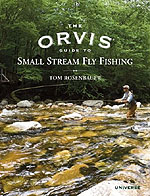This little pattern will sink just like a beadhead and will imitate the colors a golden stone nymph has, almost to perfection. Follow the tying sequences in the article to make your own! Steve Schweitzer has created another killer!
On Western streams and rivers, fishing a golden stone pattern as a searching nymph can yield surprising results when no other pattern will seem to work. This little pattern will sink just like a beadhead and will imitate the colors a golden stone nymph has, almost to perfection. Follow the tying sequences below to make your own!
What do trout actually see?

Through water and with sunlight backlighting the fly, the Gold Nugget stonefly nymph presents the color and the heavy segmentation a golden stonefly nymph has. Although one can never re-created exactly what a trout sees underwater, this photograph is representative of the colors, shapes and silhuettes a trout may see.
The Bill of Materials

There are just a few materials needed for the Gold Nugget
- any curved nymph hook (size 12 works perfectly for this example)
- clear yellow and dark pearlesent craft glass beads
- medium brown rabbit fur dubbing
- a turkey feather
- golden goose biots
- a permanent brown craft marker.
Step 1.
TYING TIP How do you prevent the turkey feather fibers from splitting when I attach them to the hook? Easy! coat an entire feather with a thin application of tying cement or preferably Softex. Let dry and just peel away the segments you need!
In our tying example, a #16 curved shank nymph hook, de-barbed, is used. Place the pearlesent glass craft bead on the hookshank and place in the vise. Tie on a prepared turkey feather strip to the 1/3 point on the hookshank. Prepare a dubbing loop with plenty of rabbit hair dubbing.

Step 2.
TYING TIP Don't be afraid to use too much dubbing here. Too much won't hurt you. Wrap it all on!
Using hare's ear or hare's mask dubbing, dub a rather thick abdomen section, ensuring the guard hair fibers are sticking out, looking downright ugly. Brush the fibers with a toothbrush or dubbing teaser to get all the fibers outward.

Step 3.
TYING TIP Crowd the beadhead with dubbing so the turkey tail top has a more wide-diameter place to rest once it is tied in. This will widen the top of the carapice the turkey tail is representing.
Bring the turkey tail over the top and tie off at the beadhead. Whip finish and remove the fly from the vise.

Step 4.
TYING TIP De-barb the hook to get the beads on more easily.
Place 4 clear yellow glass craft beads on the hook shank and hold them in place with a "wedge" of dubbing...just enough to hold them in.

Step 5.
TYING TIP To make tying biots on more easy, build up a tapered butt section with dubbing.
Tie in two golden goose biots at the edge of the last bead. Prepare a fine bit of dubbing (as shown in the picture) to wrap over the biots and hold everything in place. Tie off and place a drop of thin tying cement at the tail and at the head.

Final Step
TYING TIP It doesn't hurt to color the turkey tail topping to darken it up a little bit.
Golden stones are lighter in color on the bottom than they are on top. By using a permanent brown craft marker, color the top of the beads to imitate the natural more closely. You're done!


A finished Gold Nugget ready to fool a Western river trout.
- Log in to post comments








Beautiful concept. I
Beautiful concept. Ive been toying with these and other glass beads, having made several soft hackle, Yorkshire-style spiders with bead bodies. This dovetails nicely from that.
I only hope these work on my SE USA bluegill - I suspect they will.
Another winner- than
Another winner- thanks Martin J. for making it possible. I have bunches of these beads, and they are common as dirt. I'd like to add they are usually seen where I buy them as 6/0 size or sometime "E."
I've experimenting with ways to use them, as well as working out a good nymph pattern for next season - now I know what I'll do.
Thank you, sir!
Cordell,
The prep
Cordell,
The preparation merely consist of taking of a few barbs--5-10 or so depending on the size of the fly--from one side of the feather, keeping them together as a flat band to form the back of the fly.
Martin
Will someone explain
Will someone explain to me what is meant by a 'prepared turkey feather' from step one? Thank you
Well done Im on this
Well done Im on this pattern right now, it looks cool and a little belter. Thanks jan Johansen
Wholy smokes.....fis
Wholy smokes.....fish gobbled them, tippet and all (sucked, but alas, wadda ya gonna do)! Great pattern. Added deer hair legs, knocked 'em dead!
Where can I buy thes
Where can I buy these beads?
This pattern is real
This pattern is really well compared to some of the stoneflies I've seen in Canadian waters.
Thank you.
Thomas